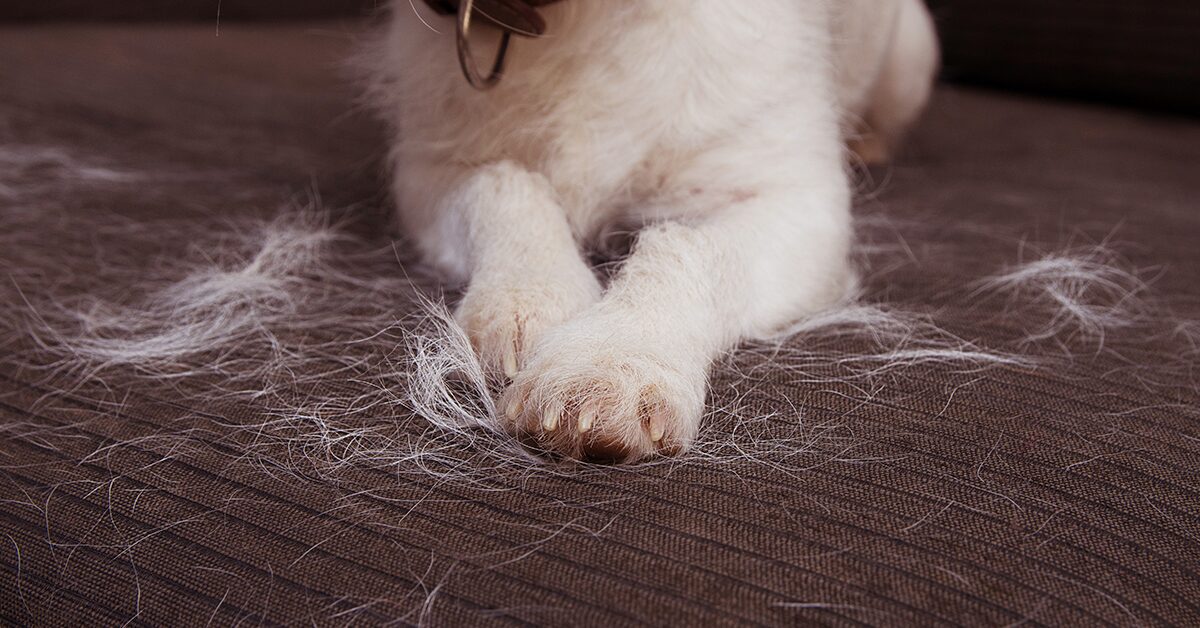As many pet parents will attest, owning a dog is an amazing, rewarding experience. Over time, you come to understand why dogs have earned the title of “man’s best friend.”
Although our furry friends are a joy to have, shedding can be a frustrating aspect of pet ownership. If you find yourself in this situation, you might be asking, “Why is my dog shedding so much?”
Here’s the lowdown on why dogs shed, what’s considered a normal amount of shedding for your breed, and a couple reasons why your dog might be shedding more than usual.
Why do dogs shed?
A dog’s fur is their first line of defense against the elements. Their fur helps them regulate their body temperature throughout the seasons and protects them from all types of undesirable situations, such as damaging UV rays, pesky insects, rough weather, and other potentially harmful environmental conditions.
Shedding is a normal part of any healthy dog’s life. Depending on the season and your dog’s breed and age, they may be shedding more or less than usual. Shedding is usually nothing to be concerned about, as it is a normal part of a dog’s yearly cycle of growth and development.
When a dog sheds their fur or “coat,” it’s removing old, dead hair they no longer need.
If you have noticed an unusual amount of shedding or excessive shedding in specific, patchy areas, you might be asking yourself, “Why is my dog shedding so much?” It could be happening for a couple of reasons, and we’re here tp help you get to the bottom of their heavy shedding.
What type of fur does your dog have?
The American Kennel Club recognizes 197 different dog breeds throughout the world, each one as unique as the next. Different types of dogs mean different types of coats, so it can be difficult to know what a standard amount of shedding is.
The two main types of dog coats are single coats and double coats. It’s important to know which type of coat your dog has as it can determine how much they normally shed throughout the year.
- Single Coat: As the name suggests, single-coated dogs only have a single coat of fur covering their body. They are known to shed less than double-coated breeds and usually do not go through the same seasonal shedding that a double-coated dog will go through. A single-coated dog will usually shed a consistent amount throughout the year.
- Double Coat: Double-coated dogs have a short undercoat and a longer overcoat that helps regulate temperature throughout the seasons. These dogs take a little more maintenance and need to be groomed regularly. With a double-coated breed, you can expect a good amount of shedding as the seasons change, specifically in the fall and spring months as they adjust to the upcoming temperatures. Some common examples of double-coated breeds are the Siberian Husky, German Shepherd, and Labrador Retriever.
What type of hair do they have?
Another way to categorize dogs and their shedding habits is by their hair type and length. Each type of dog hair will have a different amount of shedding and hair growth throughout the year.
- Short Coat: Short-coated dogs do not have a winter coat. They tend to shed more frequently and consistently throughout the year because their hair is constantly growing and replacing itself. Short-coated breeds can be easily maintained with regular brushing and grooming. Their fur is characterized as having a smooth coat that lays closely to the dog’s body. When petting in the direction of the hair it will feel smooth but if petted against, the hair will feel stiff.
Some breeds included in the short-coated family are Terriers, Dachshunds, Bulldogs, and Beagles.
- Long Coat: Longer-coated dogs tend to not shed as much as other breeds but require a close eye and consistent grooming to make sure their hair does not get tangled or matted, which can lead to skin problems and potentially dangerous infections.
Some breeds included in the long-coated family are Pomeranians, Border Collies, and the Afghan Hound.
- Curly Coat: Curly-coated dogs are often referred to as “non-shedding” dogs. While they do shed some, it is usually a small negligible amount. Their hair can be categorized as wavy, soft, and curly. Like long coated breeds, curly coated dogs require consistent grooming and trimming to keep their coat clean and healthy.
Some breeds included in the curly-coat family are Poodles and Goldendoodles.
- Wire-Haired Coat: Wire-haired dogs are also considered “non shedding” dogs because their coat is stronger than other breeds. Their coat, nicknamed “broken coat,” is characterized by strong, coarse, stiff hairs. This coat is known to shed very little, making them an enjoyable pet for those suffering from pet allergies.
Some breeds in the wire-haired family are Jack Russell Terriers, Wirehaired Dachshunds, and Schnauzers.
- Hairless Dogs: It’s no surprise that these breeds don’t shed because they have no hair, making them hypoallergenic dog breeds and perfect for pet owners suffering from pet allergies.
Hairless breeds include the Chinese Crested Dog, the Hairless Chihuahua, and the Argentine Pila Dog.
Pet Pro Tip: Illnesses won’t wait to happen. It’s never too early to enroll in pet insurance. From common parasite infections, to costly hereditary illnesses, pet insurance can be worth it and can cover crucial eligible treatment your pet may need for their unexpected accidents and illnesses. Find out how pet insurance works, what pet insurance covers, and choose a plan today.
How to maintain proper pet grooming
Regardless of the type of coat your dog has, proper cleaning and grooming are important for keeping your dog happy and healthy.
Taking your dog to the groomer (or bathing them at home) and using dog-safe shampoos are two ways to ensure your dog’s coat is maintained properly. Shedding tools and brushes can also be used and are a great way to help manage your dog’s coat at home.
It is important when using shedding tools and brushes to use the correct tool on your dog as there are different brushes for different types of dog hair. The slicker brush is great at removing mats and tangles from medium- to long-hair dogs, while the bristle brush works better on short-haired dogs.
And if your pet sheds heavily, a lint roller can easily remove loose pet hair from your clothes and furniture!
Reasons your dog is shedding so much
Here are some common reasons why your dog might be shedding.
Seasonal change
As the seasons change, so does some dogs’ fur. Breeds that shed seasonally shed more in the fall and spring months as they adjust to the new temperatures and prepare for the upcoming season.
Stress
Just like us, dogs get stressed. Stress can be especially difficult for dogs to manage and can lead to health conditions such as loss of hair or appetite. If you think your dog is experiencing anxiety or stress, take measures to curb these symptoms by increasing exercise, mental stimulation, and giving them lots of belly rubs. When in doubt, reach out to your vet for help.
Diet
Nutritional imbalance can be another reason for excessive shedding. Dogs need a steady diet of proteins and fats such as omega-3 fatty acids to stay healthy, and can suffer from skin and hair issues like dry, flaky skin if fed a poor diet. Be sure to speak with your vet who can recommend the best dog food for your canine.
Allergies
Dogs can suffer from allergies just like us. Certain foods, shampoos, and even environmental factors like pollen can cause irritation and hair loss if left untreated.
Infection
Dogs love to get dirty; it’s in their nature. But in the fun of rolling around in the mud, they could have picked up a parasite or developed a rash or skin infection. If so, it could be the reason your dog is shedding more than usual. Skin infections and parasites, such as fleas or mites, can result in a loss of fur and declining health. Some signs to look out for are red, irritated patches on your dog’s skin, and scratching or biting in a specific area. It’s always good to take a closer look or get a second opinion from your local veterinarian.
Disease
Unfortunately, just like humans, dogs can develop diseases that can lead to symptoms like hair loss and damage to the hair follicles. There are ways to treat these illnesses, and it is important to consult with your local veterinarian if you think your dog might be suffering. A couple common diseases that can cause hair loss in dogs are mange, alopecia, Cushing’s disease, and thyroid conditions such as hypothyroidism.
Age
Sadly, dogs don’t stay young and spry puppies forever. As they age, their skin and coat will become weaker. If you have a senior dog and notice an increase in shedding, know that this is a normal part of the aging process as a dog gets older.
Getting to the bottom of excessive shedding
With so many different reasons for an increase in shedding it’s important to find out the root cause to get to the bottom of why your dog is shedding so much.
If your dog is suffering from an abnormal amount of shedding or thinning of their coat, there are supplements you can add to your dog’s diet to help promote hair growth. Two of the most common supplements are fish oil and Biotin, but talk to your veterinarian to get the best recommendation.
Remember: your dog’s increase in shedding could be as simple as a changing of the seasons or as serious as an infection or illness. It’s important to understand the type of coat your dog has, keep up with regular vet visits, and reach out to a professional if need be.




